Russian War Report: Geolocating fires in Bryansk
On April 25, large fires were reported in Bryansk, Russia, just 100 kilometers from the Ukrainian border. DFRLab geolocated the fires to confirm an armed forces fuel depot was damaged.
Russian War Report: Geolocating fires in Bryansk
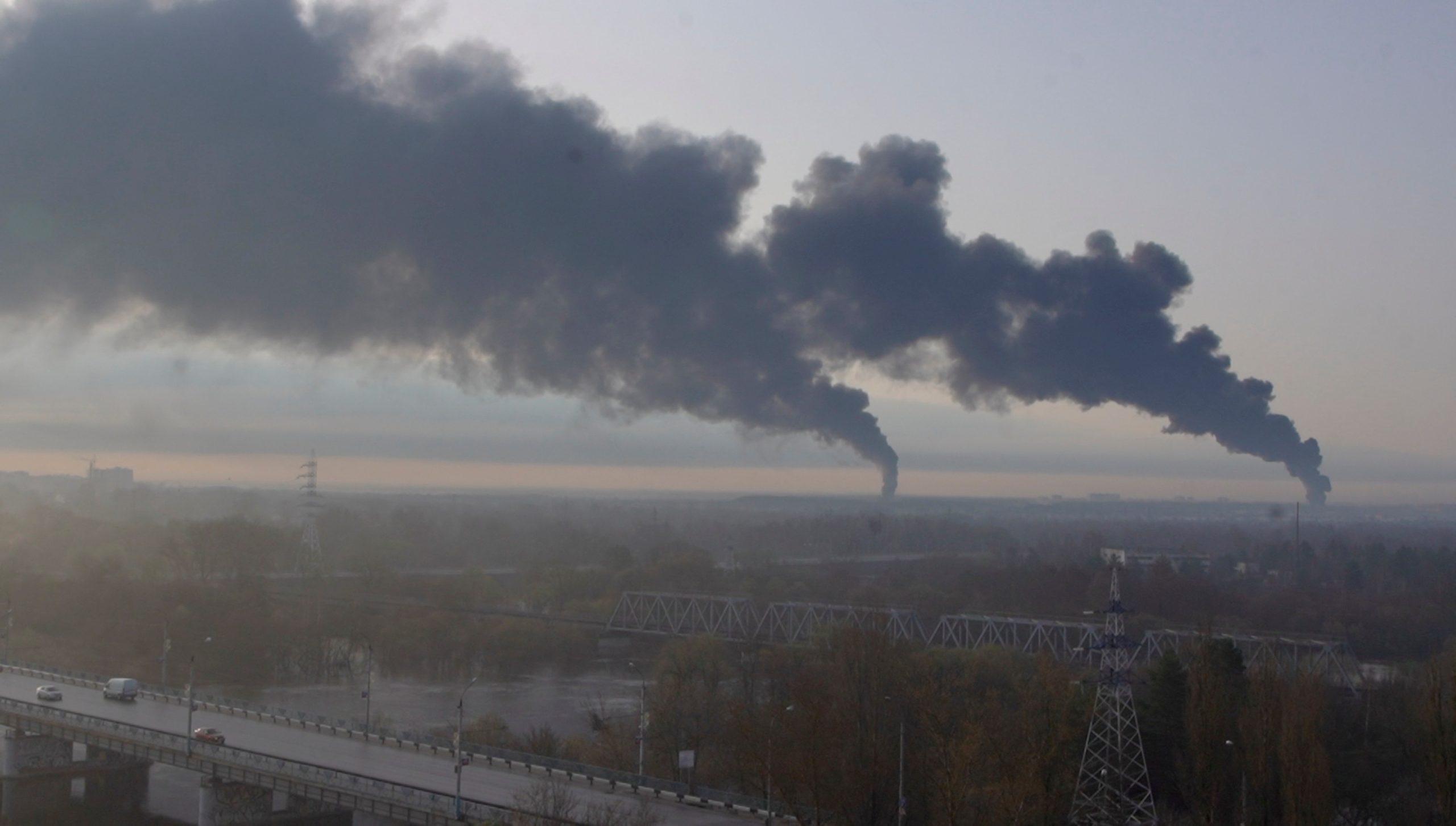
As Russia continues its assault on Ukraine, the Atlantic Council’s Digital Forensic Research Lab (DFRLab) is keeping a close eye on Russia’s movements across the military, cyber, and information domains. With more than seven years of experience monitoring the situation in Ukraine, as well as Russia’s use of propaganda and disinformation to undermine the United States, NATO, and the European Union, the DFRLab’s global team presents the latest installment of the Russian War Report.
Security
Tracking Narratives
Russian infrastructure damaged in Bryansk fires
On the morning of April 25, a Kyiv Independent journalist reported large fires in Bryansk, a Russian city 100 kilometers from the Ukraine border. Footage and photos of the fire, filmed from various locations in the city, circulated on social media. Bryansk sits along the Druzhba pipeline, which is the only pipeline exporting Russian oil to Europe.
The DFRLab geolocated the images to southern Bryansk, where the footage suggested a Russian armed forces fuel depot (in blue below) and a Rosneft oil depot (in purple below) had both caught fire. Open-source researchers reported that some fires burned for at least 12 hours.
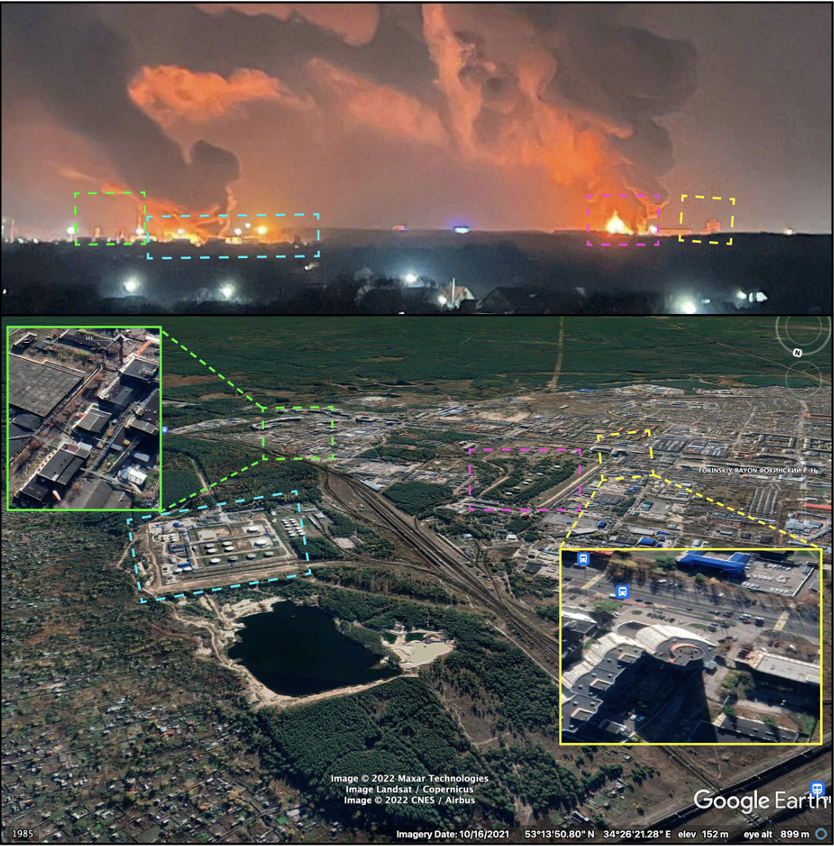
The cause of the fire has not been confirmed. Footage showing the fires igniting suddenly was posted online, the audio for which some have speculated indicates a possible missile strike. Bryansk is a key city along the Druzhba pipeline, which is the only pipeline exporting Russian oil to Europe.
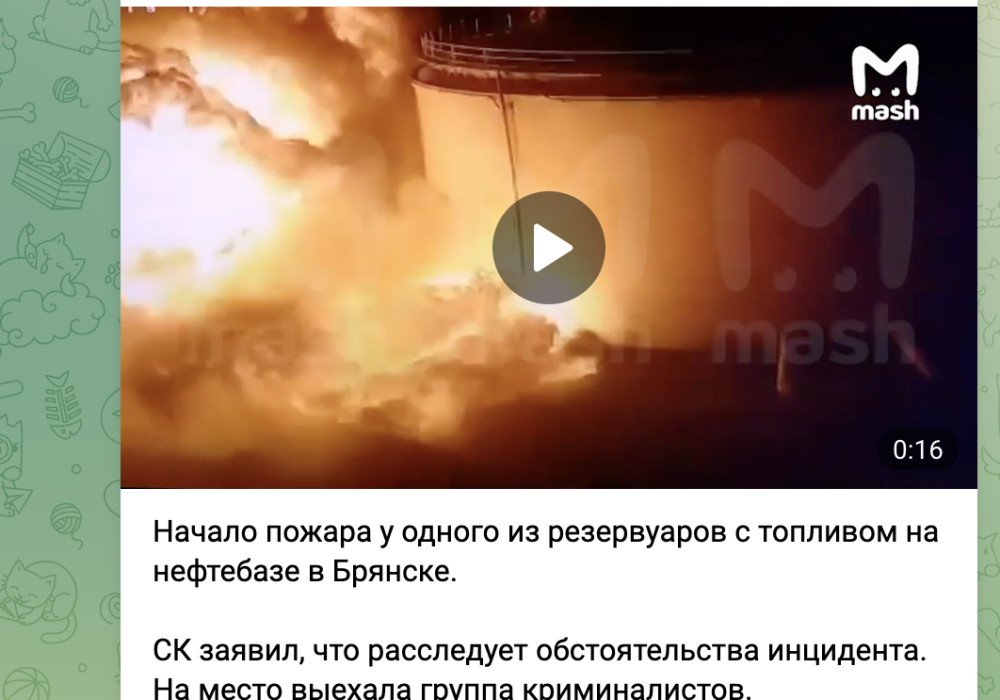
Additionally, another video surfaced on the same day, allegedly from Bryansk, showing derailed train cars with fallen military vehicles, but the DFRLab was not able to confirm its location by the time of publishing. The cause of the alleged accident is unknown.
—Lukas Andriukaitis, Associate Director, Brussels, Belgium
Putin at Orthodox Easter service: Independent media in Ukraine, Belarus, and Russia raise skepticism, fact checks say otherwise
Independent media in Ukraine, Belarus, and Russia reported on inconsistencies spotted during Russia’s televised Orthodox Easter service, which took place on April 24 at the Cathedral of Christ the Savior. The reports all suggested that Russian President Vladimir Putin’s presence at the service had been staged. This allegation fits into an anti-Kremlin narrative that Putin is paranoid and avoids large gatherings. Fact checks of the media reports, by the DFRLab and others, point to the inaccuracy of the claims.
NEXTA Live, a pro-democracy Belarusian outlet, and Telegram channel Bystry Fokus cited social media sources, such as Igor Sushko’s account on Twitter, that pointed out that in one shot Putin is visible standing in front of a painting of a crown but in the following shot he is not visible.
Though it is true that Putin cannot be seen in the second shot, it could be the result of the different camera angle. In the zoomed-out shot, a figure is standing in the same position where Putin stood, to the right of Moscow Mayor Sergey Sobyanin, but the footage is too low-resolution to identify definitively that the individual was Putin.
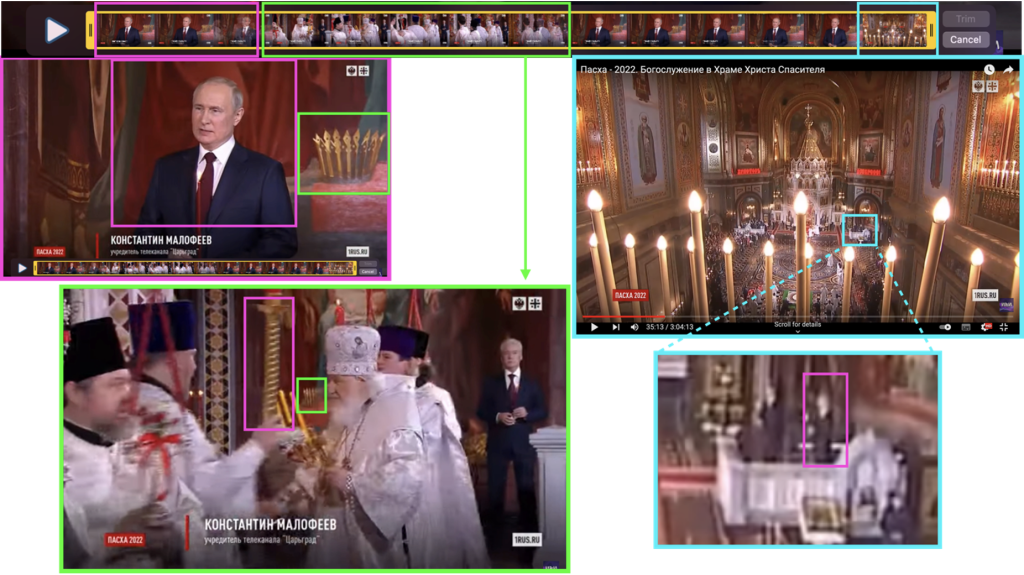
Sushko threw doubts on Putin’s presence at the service, however, when he posted an anonymous video supposedly showing the pre-recorded appearance of Putin, saying that the church was “emptied.” At the outset of the video, however, a fleeting glimpse of a crowd of people is captured in the background. And Sushko, in designating the church as “emptied,” fails to account for the cordoned off space directly in front of the altar, across which the video was filmed. The candid video was possibly showing the events prior to the beginning of the televised religious service.
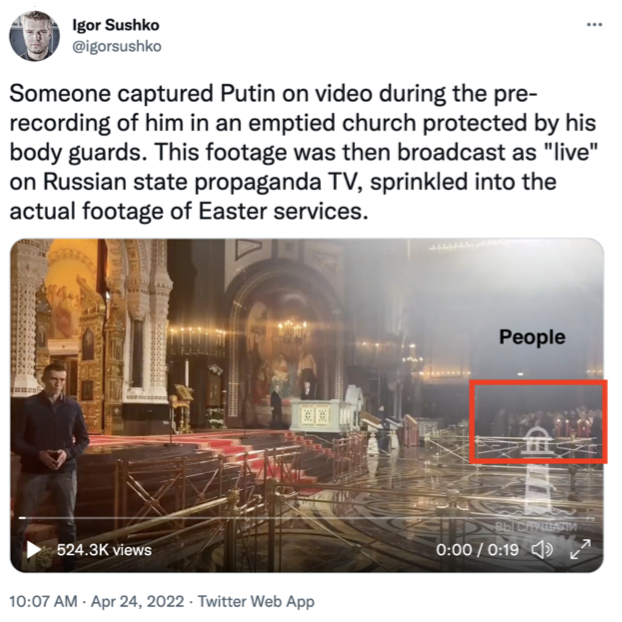
Ukrainian media outlets Antikor and Unian, along with Russian independent outlet The Village, furthered the narrative, alleging that Putin’s office reused old photos from the 2021 Orthodox Easter service and supporting their claims with an allegation that Putin and Sobyanin appeared to be wearing the same clothes in the 2022 broadcast as they wore in 2021.
The DFRLab compared photos, published on the Kremlin’s website, from the Orthodox Easter service on May 2, 2021, and on April 24, 2022. The photos were similar but not identical.
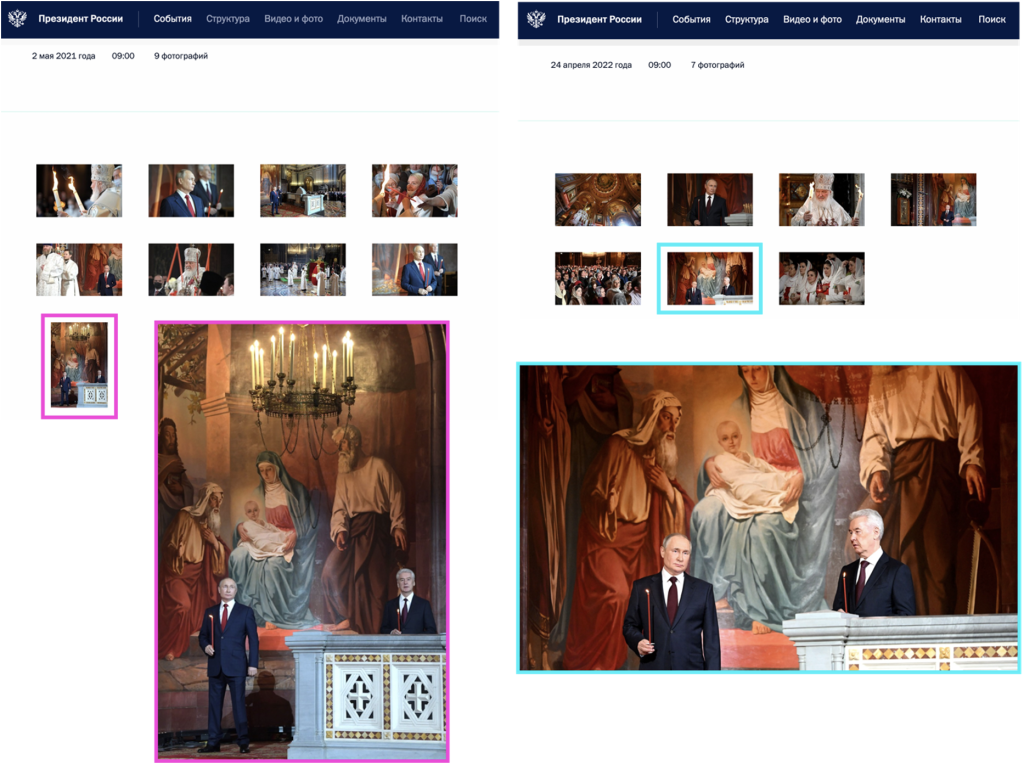
Comparison of photos published on Kremlin.ru of Putin’s attendance at the Orthodox Easter service in 2021 (pink boxes) and 2022 (blue boxes). (Source: Kremlin.ru/archive, left; Kremlin.ru/archive, right)
One theory suggested that Kremlin.ru changed the photos after media started pointing at the consistency, and thus the “same-ness,” of the images, but an archived version of the April 24 photos does not corroborate this theory.
There is a possibility that the footage for 2022 was deliberately darkened – as alleged by Sushko – to obscure reuse of footage from 2021, and such a tweak would account for Putin’s darker seeming suit and tie. There is, however, one piece of evidence that shows a clear difference: in the footage and photos from 2021, Putin holds a red candle without a drip protector; in the footage and photos from 2022, he holds a candle with a drip protector.
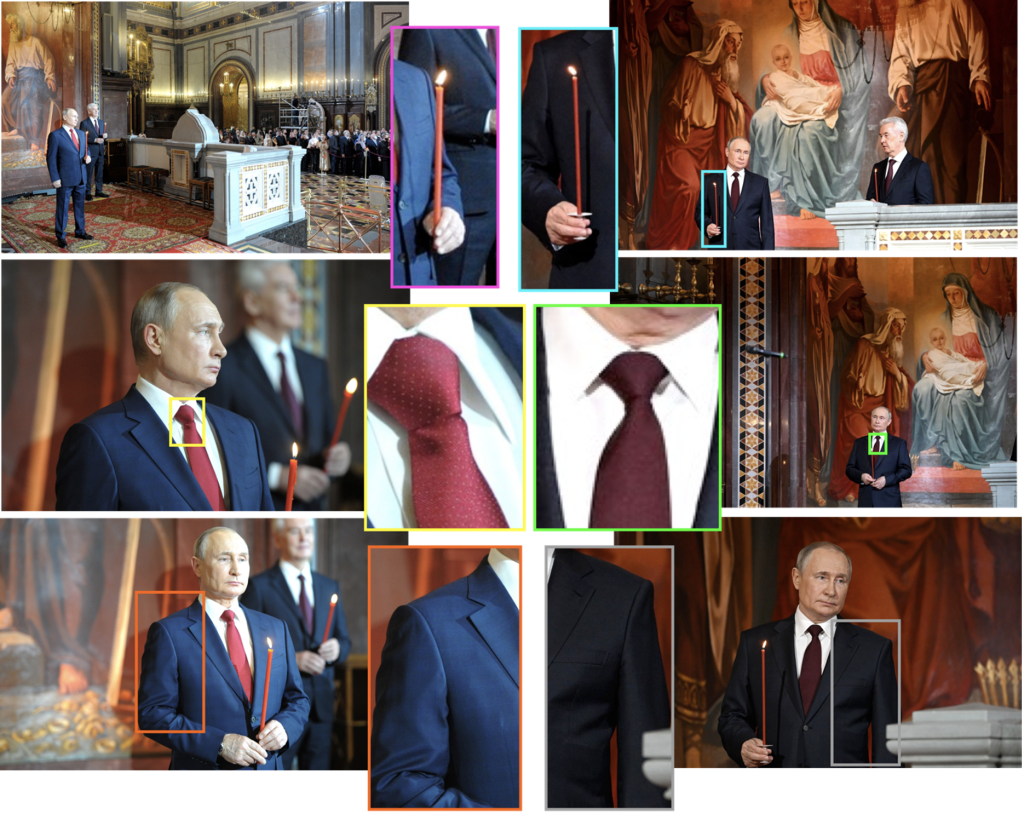
The Associated Press issued a fact check of the claim that the Kremlin had reused old images and video, determining it to be false, in part supporting his attendance by direct evidence: “an Associated Press photographer was at the service and captured pictures of Putin at the event.”
—Nika Aleksejeva, Lead Researcher, Riga, Latvia
Russians attempts to discredit Ukrainian President Volodymyr Zelenskyy by portraying him as a drug addict, again
Russian Telegram channels recently circulated a manipulated video of a call between Ukrainian President Volodymyr Zelenskyy and billionaire entrepreneur Elon Musk that allegedly showed evidence of the former’s drug use. In the manipulated video, white powder is seen on the desk next to Zelenskyy, which commenters on the posts claimed to be cocaine. In the original video published to Zelenskyy’s official Instagram channel on March 6, however, no white powder is visible, confirming that someone had edited the powder into the version found on Telegram. The fake video was subsequently debunked by AP and the Ukrainian Center for Strategic Communications.
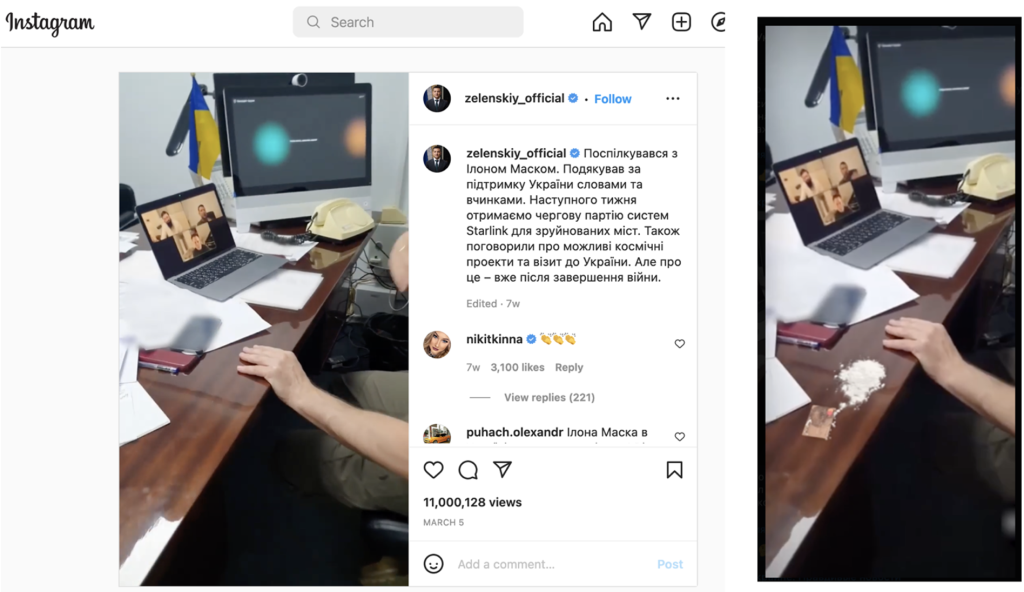
The attempt to portray Zelenskyy as a drug addict was not a one-off event, as Russian President Vladimir Putin used the claim as one excuse for invading Ukraine at the war’s outset and Russian media continue to smear the Ukrainian president with the label.
Earlier, pro-Kremlin Telegram channels claimed that cocaine was supposedly visible in another video published to Zelenskyy’s official Instagram page. In the video, Zelenskyy looks tired, but the video seems to have been filmed in the evening and published at 8:38 p.m. Commenters claimed to have spotted supposed traces of powder on the table. With high-resolution video, however, it was evident that those “traces” were ornamentation on the table and a reflection of a photo frame on the polished table surface, as confirmed by other fact-checking organizations. This did not stop at least one Russian commenter from amplifying a fringe German website that amplified the claim.
Previously, to support the allegations of Zelenskyy’s supposed drug addiction, Russian media quoted disgraced former member of the Ukrainian parliament Ilya Kyva, cited a Russian narcology expert, and quoted random commenters, but none of their claims contained any actual evidence to support the claim. The head of Russia-annexed Crimea, Sergey Aksenov, also commented on a different video that Zelenskyy is a “junkie,” a mention that was later picked up by Radio Sputnik.
—Roman Osadchuk, Research Associate
Pro-Kremlin sources continue to distort narratives around delivery of new weaponry and aid to Ukraine
Kremlin-tied Telegram channels continue attacking the credibility of Ukrainian authorities with a focus on their handling of weapons and supplies from – and the doubt that handling supposedly conveys among – Ukraine’s Western allies.
In a post on April 23, MediaKiller, a Telegram channel that pushed a fake BBC video a few weeks ago, declared that “the US is seriously worried about the humanitarian aid it has sent to Ukraine.” To support this statement, the channel quoted two CNN pieces: an article and a video on the challenges around the logistics of transfer and trackability of weapons due to their size and portability. The Telegram channel subsequently distorted those pieces to portray the United States as being “seriously concerned.” While the CNN video does start with the anchor asking “is the worry that these weapons could potentially fall into the Russians hands?,” reporter Katie Bo Lillis, who covered the story, immediately rebuts that idea, saying “not exactly” before giving a lengthier explanation about why traceability is difficult during times of war. During Lillis’s segment, a chyron below her reads “it appears to be a risk the [US President Joe] Biden administration is willing to take.”
![Screencap of CNN report on US provision of weapons to Ukraine. The chyron at the bottom states that, despite the difficulty of tracking the provided weapons, “it appears to be a risk the [US President Joe] Biden administration is willing to take.” (Source: CNN)](https://www.atlanticcouncil.org/wp-content/uploads/2022/04/Screen-Shot-2022-04-26-at-2.55.44-PM-1024x583.png)
Screencap of CNN report on US provision of weapons to Ukraine. The chyron at the bottom states that, despite the difficulty of tracking the provided weapons, “it appears to be a risk the [US President Joe] Biden administration is willing to take.” (Source: CNN)
To support its argument, however, MediaKiller isolated a passage on the weapons in Afghanistan that ended up on the black market to draw a comparison to Ukraine but failed to mention that both CNN pieces state that US officials perceive the long-term risk in supplying Ukraine with weapons to be an acceptable one. In the same passage, the channel provided unsubstantiated claims that cases of humanitarian aid had been stolen or misused, basing these assertions on three blogposts in which the authors claimed without evidence that Ukraine is selling the aid.
Elsewhere, pro-Kremlin Telegram channel “Legitimniy” claimed that NATO-supplied weapons would be placed exclusively in the Western part of Ukraine to replenish the Soviet era equipment being moved to the frontline. The primary rationale, it claims, was that new equipment requires ammunition manufactured in NATO countries that would be hard to deliver to the warzone. While the statement sounds like a truism, the channel elides the fact that the old equipment would also require deliveries of ammunition as well, regardless of the equipment’s provenance. The post received 1.9 million views, which is eight to nine times higher than the engagement the channel’s other publications normally receives, and – because it was on Telegram – it is difficult to determine whether those views were legitimate or comprised some form of artificial amplification.
—Roman Osadchuk, Research Associate
Russia’s security service seemingly fabricated evidence of Ukrainian plot to kill Russian propagandist
On April 25, Russia’s Federal Security Service (FSB) claimed that it had foiled a Ukranian plot to kill Vladimir Solovyov, a prominent Kremlin propagandist. In its statement, the FSB claimed that it had arrested Russian nationals – a group of “neo-Nazis” – who had allegedly been hired by Ukraine’s State Security Service (SBU).
Russia’s Investigative Committee released a four-minute video that allegedly showed the arrests as well as the raid on the suspects’ apartment. In the video, the FSB agents appeared to seize property allegedly belonging to a supposed neo-Nazi group. Some parts of the video were blurred – including the faces of the detainees and a portion of the seized belongings. Separately, Kremlin-owned outlet ria.ru released a longer video of the FSB operation that did not blur the seized belongings. The unveiling of the the supposedly seized belongings in this longer video sparked a widespread (and often humorous) discussion on social media. As detailed in the FSB statement, among the items allegedly seized were drugs, a photograph of Adolf Hitler, a wig, a t-shirt with a swastika on the front, and fake Ukrainian passports and “nationalist literature and paraphernalia.”
Also visible in the footage were a number of copies of video game Sims 3, which open-source researchers believe were allegedly “confused [with] three mobile phone SIM cards” and comprised evidence that the whole endeavor was a fabrication, given the relatively amateur mistake.
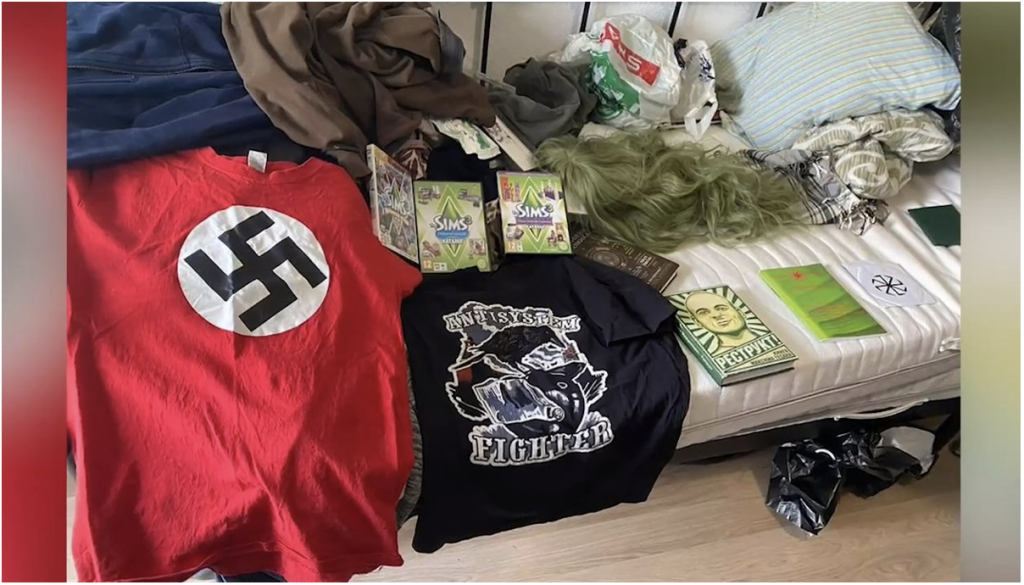
Calling it “another creative [operation] by the FSB,” the Ukrainian SBU stated that “the SBU has no plans to assassinate V. Solovyov.” The statement compared Solovyov to Joseph Goebbels, Nazi Germany’s minister of propaganda, and noted that the Kremlin propagandist “will be held accountable for his crimes in international courts following the victory of Ukraine” in its war with Russia.
—Eto Buziashvili, Research Associate, Washington DC

